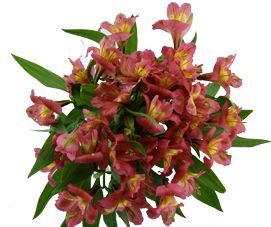The most important factors affecting the life of cut flowers in addition to maturity stage include;
 1. FOOD SUPPLY
1. FOOD SUPPLY
This refers to respiratory metabolites. In a cut flower, all the metabolites are channeled towards flower development. Starch sugar stored in the stem, leaves and petals provide much food needed for flower opening. Simple nourishing food for flowers is sugar but sugar is also a suitable substrate/ food for bacteria hence you need a good preservative
Vase life can be improved by supplying food (sugar) after harvest. e.g. in tuberose and gladiolus in which flowers open further up the spike, flowers are bigger and have a longer vase life when ‘pulsed’ with a preservative solution containing 20% sucrose prior to shipping.
In those flowers where foliage is part of flower quality, e.g. Alstroemeria, if supply of carbohydrates is inadequate, leaves ‘blacken’. Tuberose flowers pulsed with 20% sucrose showed an increase of florets opening from 34% to 57% and an increase of vase life from 5-11 days.
2. TEMPERATURE
This is the most important factor because it influences the factors. Flowers are living and respiring. Respiration increase exponentially with temperature; Temperature also affects the rate of water loss, growth and development, production and response to ethylene, growth of microbes.
To reduce water loss temperature must be kept low. Flowers held at 300 will respire 45 times faster than flowers held at 20 C. Rapid removal of field heat and optimum storage temperature for cut flowers is 0-20 C for tropical flowers, e.g. anthuriums, strelitzia and orchids, storage temperature of between 10-150 C.
3. WATER SUPPLY
Plants are about 80-90% water. Cut flowers have a high surface area to volume ratio, and frequently have many leaves; hence are prone to loosing water much more rapidly compared to most perishable commodities. By detaching the flower, its source of water supply is cut off. Cut flowers should be stored under high relative humidity 95% to minimize water loss; particularly during long term storage. Loss of water causes loss of quality, accelerated aging, ethylene production, flowers can be rehydrated provided there is no obstruction to water flow. Movement of water in the stems of cut flowers can be obstructed in a number of ways:
4. AIR EMBOLISMS
The water column in the xylem vessels is under tension due to transpiration. When the stem is cut, this tension is released and a small bubble of air enters each conducting tube.
The air bubbles do not move up the stem, and may restrict water flow when the stem is placed in a vase. Removal of embolism is re-cutting the stem about 2.5 cm under water. Rehydration is improved by acidifying the vase solution ph 3.5 or by heating the vase solution to 400 C
5. WATER QUALITY
Alkaline water does not readily flow through the cut flowers stems. Use or hard water can therefore substantially reduce flower vase life. This problem can be overcome by acidifying to a PH of 3.5-4.0 citric acid is commonly used. HQC (Hydroxy quinine citrate) at a concentration of 250ppm is also effective.
6. BACTERIAL PLUGGING
Sugar solution enhances vase life; but it is also an excellent substrate for the growth of bacteria and fungi. Bacterial and fungal growth is further enhanced by materials that leak out of the cut stem ends. Substrates produced by the bacteria, and the bacteria and the bacteria themselves may rapidly clog the fine tubes of the water conducting system. Buckets should therefore be regularly cleaned to prevent growth of bacteria (biocides like HQC)
7. PHYSIOLOGICAL PLUGGING
When a plant is cut, wounding occurs. To protect the wound, the plant produces latex (phenolics and tannins). The exudates leak into the vase solution and are later absorbed with the water. Being gummy, they block the vascular system of the cut flower; thereby hindering free flow of the vase solution. To restore free flow, re cut the stem to remove the cemented end of the flower.
8. ETHYLENE
Certain flowers especially those of caryophyllaceace family (carnations and gypsophilla) senesce rapidly if exposed to minute concentrations of ethylene. The higher the available ethylene concentration, the sooner the flower will bloom and wilt. In general, that ethylene can induce different damage symptoms including
a) Short longevity/vase life
b) Insufficient opening of the flower bud
c) Early wilting
d) Drop of buds and petals
e) Drop of buds and petals
f ) Discoloration of the flowers
Ethylene can occur at concentrations of 1-5ppm is already detrimental to cut flowers. Flowers should be handled in areas with the least ethylene contamination. Effects of ethylene can be minimized by holding produce at low temperatures and by using ethylene inhibitors e.g. silver thiosulfate and 1MCP
 1. FOOD SUPPLY
1. FOOD SUPPLY  1. Generally a very high rate of respiration- when exposed to high temperatures, they easily wilt because of rapid loss of water. Remember, flowers are used to convey emotions of love, care, to someone. It is thus presenting a wilting flower to someone is undesirable and unkind.
1. Generally a very high rate of respiration- when exposed to high temperatures, they easily wilt because of rapid loss of water. Remember, flowers are used to convey emotions of love, care, to someone. It is thus presenting a wilting flower to someone is undesirable and unkind.  1.Exposure to ethylene is the precursor to senescence of flowers. A flower that is exposed to, or is producing high levels of ethylene will age faster, thus reducing the enjoyment of its beauty by the customer.
1.Exposure to ethylene is the precursor to senescence of flowers. A flower that is exposed to, or is producing high levels of ethylene will age faster, thus reducing the enjoyment of its beauty by the customer. 


